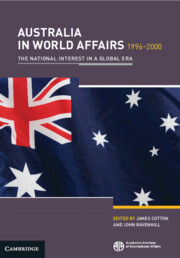Book contents
- Frontmatter
- Contents
- Figure
- Contributors
- Preface
- Abbreviations
- Part I Setting the Scene
- Part II Relationships
- Part III Issues
- 11 Facing an Uncertain Future: Defence and Security under the Howard Government
- 12 The East Timor Commitment and Its Consequences
- 13 Australia in World Environmental Affairs
- 14 Australia and the International Human Rights Regime1
- 15 Australia and the Global Economy
- 16 Australia and the Asian Economic Crisis
- References
- Index
12 - The East Timor Commitment and Its Consequences
from Part III - Issues
Published online by Cambridge University Press: 04 May 2024
- Frontmatter
- Contents
- Figure
- Contributors
- Preface
- Abbreviations
- Part I Setting the Scene
- Part II Relationships
- Part III Issues
- 11 Facing an Uncertain Future: Defence and Security under the Howard Government
- 12 The East Timor Commitment and Its Consequences
- 13 Australia in World Environmental Affairs
- 14 Australia and the International Human Rights Regime1
- 15 Australia and the Global Economy
- 16 Australia and the Asian Economic Crisis
- References
- Index
Summary
Before the events of the later 1990s, if there was one issue in Australia’s external relations on which there existed unalloyed bipartisan agreement it was East Timor. Governments of both persuasions had regarded the question of positive relations with Indonesia to be of far greater moment than the right to self-determination of the East Timorese, irrespective of the extent to which their Indonesian governors observed or denied their human rights. A Coalition government initiated the negotiation of the Timor Gap Zone of Co-operation Treaty, and a Labor government signed and ratified it. Though some thirty-two states indicated in one way or another that they accepted Indonesian sovereignty over East Timor, only the positive affirmation of that sovereignty by Australia in that treaty resulted in litigation before the International Court of Justice. Prime Minister Paul Keating had expressed the sentiment that there was no country more important than Indonesia to Australia, and later Foreign Minister Alexander Downer had repeated it. But by 2000, this constant in Australia’s regional posture had changed completely.
Keywords
- Type
- Chapter
- Information
- Australia in World Affairs 1996–2000The National Interest in a Global Era, pp. 149 - 163Publisher: Cambridge University PressFirst published in: 2024

